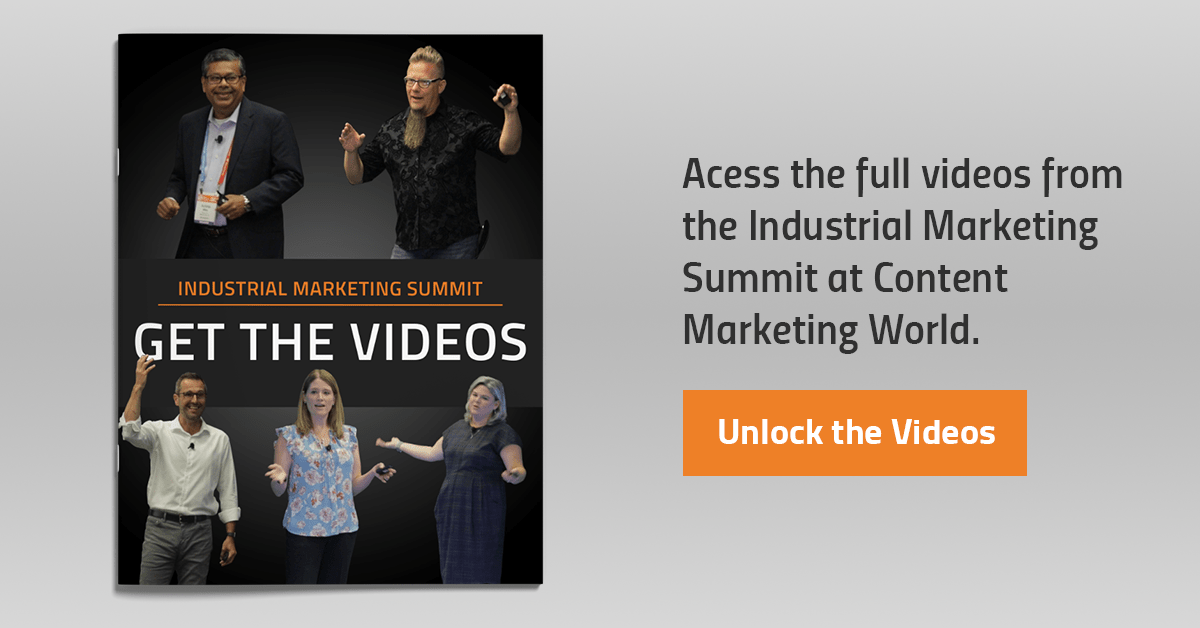How Brennan Industries’ Small Marketing Team Increased Leads 800% with Content Marketing
The Global Marketing Director of Brennan Industries is on a one-man crusade to turn industrial “Content Marketing” into “Value Marketing”.
Access the full videos from the Summit here.
Real value. That’s the reason why industrial marketers do what they do – they want to bring value to their existing and potential customers. It is also why over 100 marketers came to the Industrial Marketing Summit on September 6, 2019 – they came looking for something of value to bring back to their business.
Afternoon presenter John Joyce promised to deliver this, and boy, did he deliver.
The Global Marketing Director of Brennan Industries is on a one-man crusade to turn “Content Marketing” into “Value Marketing”. Turns out, the key ingredient that enabled his team to increase leads 800% and double Brennan’s revenue over the past year and a half is just that: deliver real value to your customers.
“Your customers go to your website or buy your product because they’re looking for value. Your content marketing should be providing real value,” says Joyce. “If there’s no value, it’s just spam.”
Think about your current marketing campaign. Better yet, think about that social post you just created. Is that providing value to your customers, or is just promotion of your product?
If you’re unsure, that’s okay. Joyce lays out his team’s framework for creating valuable content for your customers.
Is Industrial Content Marketing Relevant? Does It Work?
“Industrial marketing is different. We’re not just trying to distort somebody’s perception of something until they say, ‘Yeah, that sneaker is going to make me feel fancy, so I’m going to spend $100 on it,’” says Joyce. “It’s way more complicated in industrial marketing.”
One complexity that makes it harder for us: our buyer is hard to identify.
The first person who specifies your product or asks for a sample is often an engineer and often not the person who ultimately purchases from you. Sometimes your product goes through multiple decision makers until a person from that company buys from you.
How engineers find and specify your products also changes this product. Some go through distributors, procurement, directly from your website, direct to OEMs and even the web monster Google itself.
The buying process for your customers is long – and different for each lead. (Not to mention, industry verticals and buyer personas.) With all these complications in understanding and reaching our buyers, effective content marketing becomes an ever-increasing challenge.
So, is it worth it, and can it actually work?
“Yeah! It totally, actually works!” says Joyce. “Except for a little bit of brand-building we do in trade publications, all of the advertising supports content. We don’t advertise for anything other than content,” says Joyce.
In the past two years, Joyce and his team have built-out their content marketing strategy. This has resulted in a massive uptick in leads and sales, Joyce says.

How to Create Valuable Content in Your Marketing Campaigns: Be Different.
Being different doesn’t mean that Brennan Industries doesn’t use some of the same marketing tactics as other manufacturers. Joyce’s team still makes guides, whitepapers, blog posts, videos, technical data, CAD models and more – all with the goal of providing real value.
“It matters to somebody to have that information. It saves them time, right? CAD files save an engineer time,” says Joyce. “Our parts are super-simple commodity parts. An engineer does not want to sit there and spend an hour modeling an elbow fitting. He’ll say, ‘What a waste of time! I can just go to the Brennan site and download twenty of these and throw all the ones I need into my assemblies.’”
Joyce emphasizes that marketers need to begin the relationship with engineers with value. The conversation you have with a potential customer starts with how you can add value to the engineer’s life and make their job easier.
“What better message can you be sending into your marketplace other than: We provide value?” Joyce adds.
One way that Brennan does this differently than other B2B or B2C marketers is with their landing pages. Ignoring the advice to keep their forms short, Joyce uses long and specific forms for the content his team creates. They work.
“It’s working great. It has not slowed-down anything,” says Joyce.
These form submissions then give data to his team to build buyer personas, including what products they are interested in.
But enormous forms are not his strategy. They are a part of an overall content marketing perspective focused on bring value to the customer.
Here’s Joyce’s 4-part strategy to content marketing.
Nugget 1: Listen
The first step in providing value to your customers is to listen to them.
“You have to listen. How do you provide value? You need to know what people want. This sounds super easy… but have you ever found yourself not doing it?” says Joyce.
As marketers, we can often get distracted by what other marketers say we should be doing. Write your content for SEO! Be on every social media platform! Use bright colors! Make sure every piece of content you put out can tie the customer back into the buying cycle!
The problem with this is that not every bit of advice we see from the marketing world will provide value to our customers. The consequences of doing it their way lead to providing worthless content to our audience, who then remember our brand as one that provides worthless, spammy content.
Really, the only thing we should be doing as marketers are those things our customers tell us they need or want.
“If you write content that really matters to them, teaches them something, saves them money, educates them in some way, provides them value that’s real, then you win them,” says Joyce.
Joyce shared just one chart with the audience, which he called his KPI for engagement. The chart tracked forms for gated content on the Brennan website that were filled out and submitted since 2016 when the team began their industrial content marketing campaign.
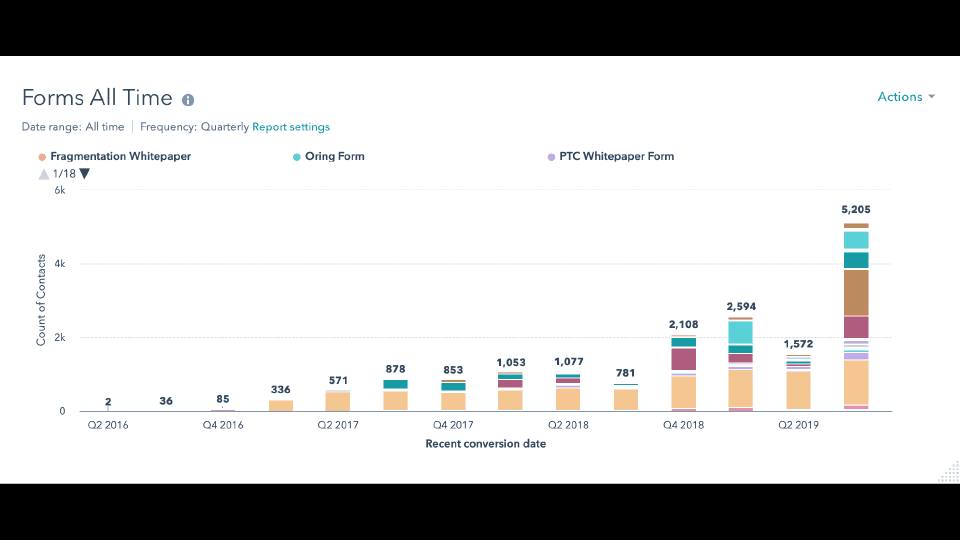
The first area on the chart, Q2 2016, showed only two submissions. Compare that to Q3 of 2019: 5,205 form submissions. That’s an enormous turn-around and a testimate to the team’s patience and confidence in their strategy.
Joyce points out how long it took them to start seeing results, encouraging others to play the long game of a content marketing strategy rather than the short-term game. Undulations are normal and can be expected in content marketing as Brennan experienced.
Take a look at all the different colored bars: those represent all the different pieces of content now available on Brennan’s website. As the team amplified their content and created new content, engineers had more options to choose from. Some pieces of content remained steady (CAD downloads represent the bottom yellow bar, which was the long-time leader for lead generation), while others took-off in bursts.
Brennan found more ways (created more content) to provide even more value to their customers.
“It takes time, but you got to keep the pressure and keep providing value. You don’t want to go after anything other than providing value,” says Joyce.
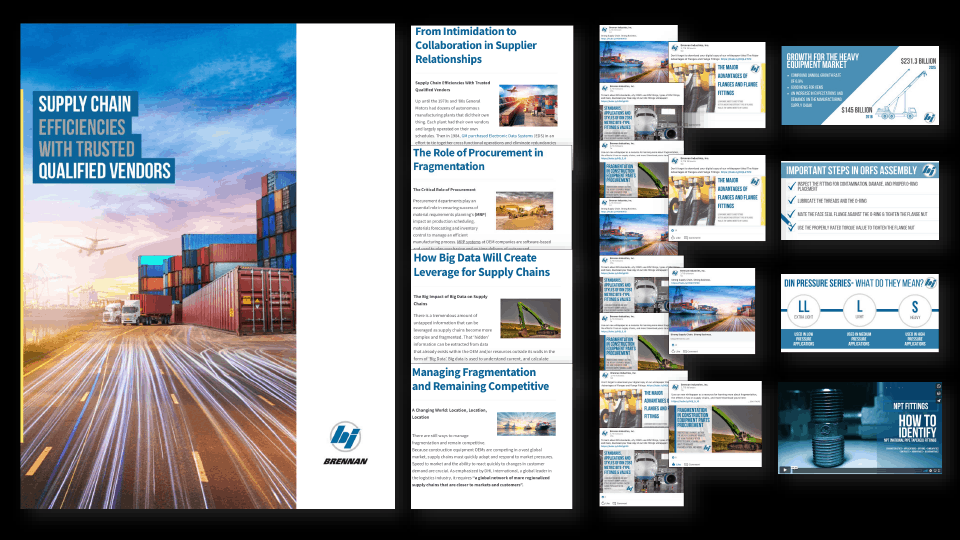
Nugget 2: Multiply
How did Brennan create all those pieces of content – each their own lead-generating tool?
By cleverly multiplying their valuable content.
Here is Joyce’s formula:
- Create a whitepaper – the premium content or ultimate piece of authority on your chosen topic. This is a long-form piece available as a PDF for customers to download from your website.
- Create blog posts from that whitepaper. You can create multiple blog posts from that long-form pillar post or premium content. These include a call-to-action (CTA) that link to the whitepaper.
- Create social posts from the blog posts. You already have the images and content. You’re just repurposing and tweaking it to fit the audience on each platform your company uses.
- Add new content into the mix. Turn that piece of content into a different format – i.e. infographics, videos, slide decks, etc.
“You’re not creating a new thing every single time… we created 20 pieces of content all originating from a premium piece of content,” says Joyce.
Finally – Step 5 – you repeat steps 1-4 for a different product line, buyer persona, industry vertical, etc. Executing this strategy has produced results (in the form for leads) for Brennan’s team and enabled them to increase their revenue velocity.
Joyce and his team can create more high-quality content faster because they’re not starting from scratch for each new content.
They built a process – a proven process – and then they execute it.
“After coming here,” Joyce says of Content Marketing World, “One of our takeaways from [Content Marketing World] is to go back to that first set of content and make it better.”
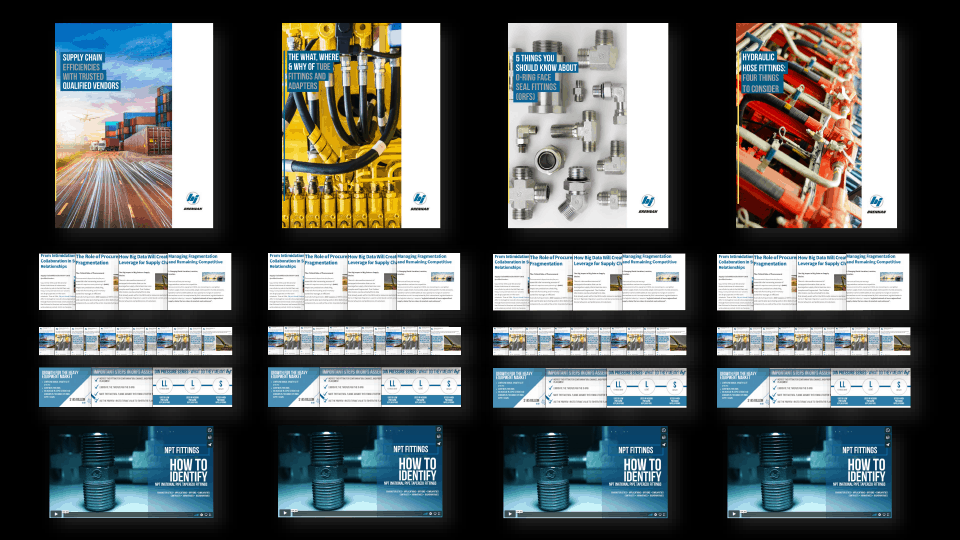
Nugget 3: In Real Life (IRL)
You’ve heard other industrial marketers say, “Engineer don’t want your catalog.”
This statement is true for most engineers. But some really fricken’ do want your paper catalog.
This is how Brennan has set itself apart from others in their industry, and this new-old-style strategy has been wildly effective. Joyce argues that the physical stuff – not virtual stuff – matter more today because of the prevalence of digital and inconvenience of physical.
Take a birthday card, for example. Your friend could send you a text or email saying happy birthday. Cool – thanks, Alex… But what if that friend sent you a hand-written birthday card? Today, that matters more. (Plus they paid for the stamp, so it did cost them something.)
Joyce sees this empathetic, value-driven marketing as coming full circle. His team created physical products for their customers (many of them at no cost to the engineers) that relate to their products and existing content campaigns:
- Product Line Catalogs – Brennan created small, physical catalogs for specific product lines and personas. Engineers submit a form requesting a catalog for a specific line, and Brennan then mails these at $2 each and charge the engineer nothing.
- Thread Identification & Measuring Guide – a 28-page physical guide that doesn’t exist on the Brennan website as a PDF. Engineers fill out the form, and Brennan mails it to them for free.
- Countertop Thread ID Mat – a physical tablemat that engineers can use to measure and identify fittings. Brennan’s sales team can bring this to clients on visits, and Joyce sells this on the website.
- Thread Identification Kit – a toolkit for engineers to properly identify and test BSP and Metric fittings with physical samples in the most-commonly used sizes. Brennan also sells this on their website.

“This has been so super-successful for us, this has grown into a whole string of things,” says Joyce. “It just shows no sign of slowing down.”
Joyce’s team hit a nerve.
The team had +1,000 requests within 24 hours of releasing the first physical catalog, which now make up 100% of Joyce’s direct mail budget. Like their multiply strategy, Joyce’s team created new, tangible content around this campaign, including a tablemat with product spec’s and a real-life thread I.D. kit. Both are products Brennan now sells, and both have seen tremendous positive feedback since their launch. Next for this campaign is an educational series around thread identification.
“There is a high-perceived value on this kit, too. So when we give it away or sell it at a discount, people love it,” says Joyce.
By the way, the idea for this guide came from a sales representative who said engineers need this type of guide. So, this piece is not only a great example of real-life marketing but also of listening.
Nugget 4: Link
How do all these pieces of content tie together? With smart link-building based on buyer personas and campaigns.
Link-building is a massive, massive campaign. There are many ways to link content together in a way that leads the buyer to a sale. There are plenty of ways to do it wrong. When you start to build it – as Brennan recently did – you must lead with intention.
Brennan had over 50 different forms engineers could fill out on the website. They had over 10 premium content pieces, all of which had a slew of blog posts, videos and more. A year ago, these would have looked like a randomized mess to your OCD CMO. Today, Brennan has used links to cleverly offer more pieces of valuable content to customers based on what they previously download.
“We actually went back through all the blog posts and started tagging down at the bottom different categories,” says Joyce.
Joyce then created landing pages specific for each category, which linked the engineer to other helpful content in that category. These pages are called “resource centers”, and they’ve led to multiple downloads and events per session.
“We’re still only getting one lead, but we’re providing 4x the value by doing this,” says Joyce.
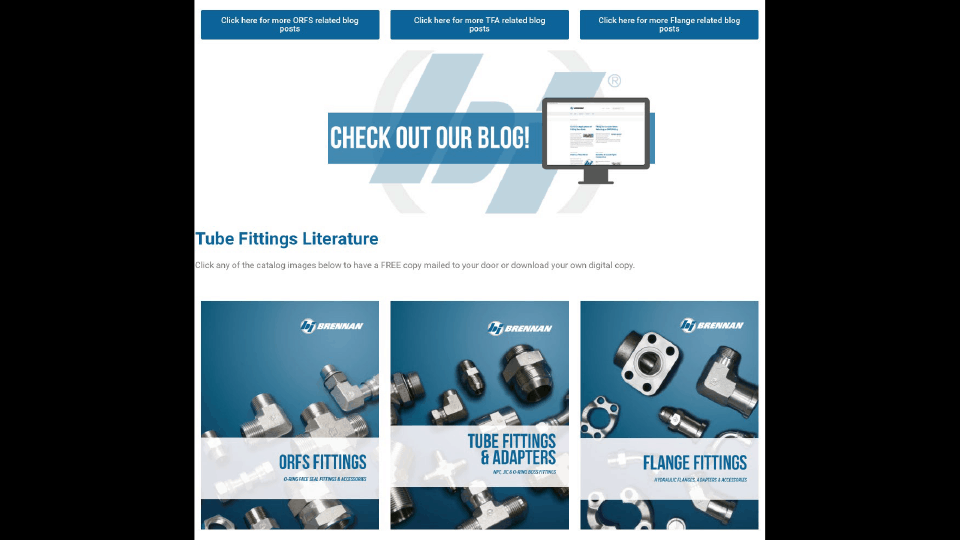
To Conclude: Be Valuable.
If you take nothing else away from this presentation, you will see improvements in your industrial content marketing strategy: bring value to your customers.
From the big ideas (like listening to your customers for content ideas) to the tactical advice (like how to create multiple pieces of content from one premium piece), Joyce shared what worked for his team. In doing so, hoping to bring value to you.
Last question for you: How will you deliver value to your customers?
Check out the Industrial Marketing Summit 2019 page to recap the whole event and watch the videos of the other speaker presentations.
Access the full videos from the Summit here.
Adam Beck
Latest posts by Adam Beck (see all)
- Engineering the World’s Longest Solar Eclipse - April 9, 2024
- How AR CAD Models and Apple Vision are Helping Engineers Become Tony Stark - March 12, 2024
- Engineering a Table From 1000 Ft of Denim and 20 Gal of Epoxy [VIDEO] - November 7, 2023


